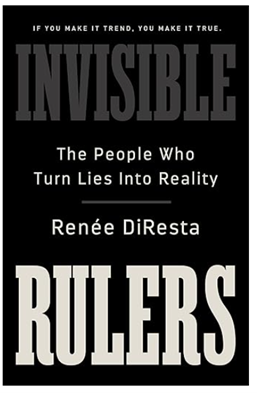By Jim Heffernan
I think maybe I’m a sucker for anything that has “invisible” in the title. It’s probably because the last 50+ years of my life have not progressed the way I thought they would. I was pretty happy about the general prospects of my family’s life in the early 70’s. My income balanced with what it cost to provide us with the basics of food, shelter, and education with a little left over for fun. I was expecting it to progress that way for our children and grandchildren. It didn’t happen that way. Not even close.
Whatever ruined our prospects has always bewildered me. I will always believe some invisible combination of forces caused the continual decline in the prospects of the working and middle class. Sadly, I believe I sometimes have been an unwitting accomplice to the process.
Renée DiResta, the author, is a manager at the Stanford Internet Observatory, where they study abuse of the truth in information technologies. She has produced an excellent book that thoroughly explores a shadowy world of influencers and algorithms who work to mold a public consensus often divorced from the truth.
The book is divided into 9 chapters. The first 4 mainly describe typical characters and mechanisms. The next 4 dig deeper into what happens when influencers and algorithms do their worst. The final chapter explores what can be done to prevent and heal the damage to our social fabric that a new generation of communications technology is doing.
The author takes us back to the 1930’s when another revolution in communications took place — the birth of broadcast radio. There was a Catholic priest, Father Couglin, who became very popular. He was a strange cocktail, pro-Catholic, anti-Communist, and pro-Nazi. His audience grew until “Kristallnacht” (“night of broken glass”) in 1938 when German Nazis took to the streets and burned and destroyed hundreds of Jewish businesses and synagogues.) Father Coughlin tried to spin it as the fault of the Jews who were persecuting Christians. He was lying. He ended up being forced off the air. There was a “fairness doctrine” back then and the airways were regarded an public property not to be misused. The Catholic Church also told him to quit what he was doing.
In 1937, Clyde Miller and a group of journalists realized what was going on with Father Coughlin and in Nazi Germany. They formed an organization called the Institute of Propaganda Analysis (IPA). They deduced that there were three tools to combat propaganda. They rejected two of the tools, suppression and counter-propaganda because they judged them ineffective. They felt the best solution was to train people to recognize propaganda on their own. They came up with a list of seven “tricks of the trade” used by invisible rulers out to sway the crowd. Here it is, and it’s still a good list. Items in quotes are from 1937. Items not in quotes are my present day examples.
- “Name Calling”-crooked Hillary
- “Glittering Generality”-Make America Great Again
- “Transfer”-I alone can fix it.
- “Testimonial”-Thomas Jefferson said
- “Plain Folks”-Real Americans
- “Card Stacking”-We want Greenland
- “Band Wagoning”-We won by a landslide.
The author proposes changes in software design and additional regulations to improve our social media, but I believe the best answer is to realize that we’re likely steered into rabbit holes by algorithms and its control and monetary gain that are the objectives of a new class of oligarchs.
I’ll close with a statement by the author.
“I’m Renee, and I study adversarial abuse online – ways that people attempt to manipulate, harass, or target others within the constantly evolving landscape of digital platforms. Sometimes this involves tracking state actors running influence operations with the intent of increasing their political power, or tearing a rival’s society apart. Sometimes it’s investigating spam and scams…which also aim to influence people, though the manipulators are usually motivated by money rather than ideology. And sometimes my work involves studying child safety issues – including, increasingly, their intersection with generative AI.
The internet is an ecosystem, and these challenges are interconnected: new technologies transform old problems.
I’m interested in exploring not only how problems manifest, but what we can do about them. And so, I write about content moderation; not only explaining how it currently works, but envisioning how it might better maximize free expression while minimizing abuse. I write about design: our tools shape how we interact with each other, and we should create them to serve us well. And finally, I translate research into policy suggestions – it’s critical to ensure sure that powerful companies remain accountable.”
Book is available Cloud and Leaf Bookstore, Manzanita and Tillamook County Library Published June 11, 2024 422 pages (70 pages acknowledgements and notes)
As always, discussion welcome at codger817@gmail.com
Not copyrighted, sharing is welcome.


